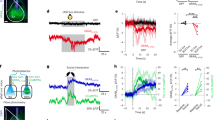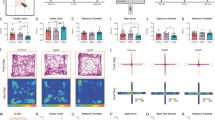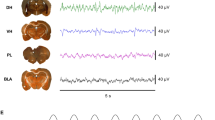Abstract
Serotonin receptor 1A knockout (Htr1aKO) mice show increased anxiety-related behavior in tests measuring innate avoidance. Here we demonstrate that Htr1aKO mice show enhanced fear conditioning to ambiguous conditioned stimuli, a hallmark of human anxiety. To examine the involvement of specific forebrain circuits in this phenotype, we developed a pharmacogenetic technique for the rapid tissue- and cell type–specific silencing of neural activity in vivo. Inhibition of neurons in the central nucleus of the amygdala suppressed conditioned responses to both ambiguous and nonambiguous cues. In contrast, inhibition of hippocampal dentate gyrus granule cells selectively suppressed conditioned responses to ambiguous cues and reversed the knockout phenotype. These data demonstrate that Htr1aKO mice have a bias in the processing of threatening cues that is moderated by hippocampal mossy-fiber circuits, and suggest that the hippocampus is important in the response to ambiguous aversive stimuli.
This is a preview of subscription content, access via your institution
Access options
Subscribe to this journal
Receive 12 print issues and online access
$209.00 per year
only $17.42 per issue
Buy this article
- Purchase on Springer Link
- Instant access to full article PDF
Prices may be subject to local taxes which are calculated during checkout





Similar content being viewed by others
References
Gross, C. et al. Serotonin1A receptor acts during development to establish normal anxiety-like behaviour in the adult. Nature 416, 396–400 (2002).
Heisler, L.K. et al. Elevated anxiety and antidepressant-like responses in serotonin 5–HT1A receptor mutant mice. Proc. Natl. Acad. Sci. USA 95, 15049–15054 (1998).
Parks, C.L., Robinson, P.S., Sibille, E., Shenk, T. & Toth, M. Increased anxiety of mice lacking the serotonin1A receptor. Proc. Natl. Acad. Sci. USA 95, 10734–10739 (1998).
Ramboz, S. et al. Serotonin receptor 1A knockout: an animal model of anxiety-related disorder. Proc. Natl. Acad. Sci. USA 95, 14476–14481 (1998).
Groenink, L. et al. 5-HT1A receptor knockout mice and mice overexpressing corticotropin-releasing hormone in models of anxiety. Eur. J. Pharmacol. 463, 185–197 (2003).
Klemenhagen, K.C., Gordon, J.A., David, D.J., Hen, R. & Gross, C.T. Increased fear response to contextual cues in mice lacking the 5-HT1A receptor. Neuropsychopharmacology 31, 101–111 (2006).
Chalmers, D.T. & Watson, S.J. Comparative anatomical distribution of 5-HT1A receptor mRNA and 5-HT1A binding in rat brain—a combined in situ hybridisation/in vitro receptor autoradiographic study. Brain Res. 561, 51–60 (1991).
Kia, H.K. et al. Immunocytochemical localization of serotonin1A receptors in the rat central nervous system. J. Comp. Neurol. 365, 289–305 (1996).
Luscher, C., Jan, L.Y., Stoffel, M., Malenka, R.C. & Nicoll, R.A. G protein–coupled inwardly rectifying K+ channels (GIRKs) mediate postsynaptic, but not presynaptic, transmitter actions in hippocampal neurons. Neuron 19, 687–695 (1997).
Sibille, E., Pavlides, C., Benke, D. & Toth, M. Genetic inactivation of the serotonin(1A) receptor in mice results in downregulation of major GABA(A) receptor α subunits, reduction of GABA(A) receptor binding, and benzodiazepine-resistant anxiety. J. Neurosci. 20, 2758–2765 (2000).
Bannerman, D.M. et al. Regional dissociations within the hippocampus—memory and anxiety. Neurosci. Biobehav. Rev. 28, 273–283 (2004).
Kjelstrup, K.G. et al. Reduced fear expression after lesions of the ventral hippocampus. Proc. Natl. Acad. Sci. USA 99, 10825–10830 (2002).
Best, M.R. & Best, P.J. The effects of state of consciousness and latent inhibition on hippocampal unit activity in the rat during conditioning. Exp. Neurol. 51, 564–573 (1976).
Delgado-Garcia, J.M. & Gruart, A. Building new motor responses: eyelid conditioning revisited. Trends Neurosci. 29, 330–338 (2006).
Munera, A., Gruart, A., Munoz, M.D., Fernandez-Mas, R. & Delgado-Garcia, J.M. Hippocampal pyramidal cell activity encodes conditioned stimulus predictive value during classical conditioning in alert cats. J. Neurophysiol. 86, 2571–2582 (2001).
Pokorny, J. & Yamamoto, T. Postnatal ontogenesis of hippocampal CA1 area in rats. I. Development of dendritic arborisation in pyramidal neurons. Brain Res. Bull. 7, 113–120 (1981).
Okuhara, D.Y. & Beck, S.G. 5-HT1A receptor linked to inward-rectifying potassium current in hippocampal CA3 pyramidal cells. J. Neurophysiol. 71, 2161–2167 (1994).
Tan, E.M. et al. Selective and quickly reversible inactivation of mammalian neurons in vivo using the Drosophila allatostatin receptor. Neuron 51, 157–170 (2006).
Haddjeri, N., Blier, P. & de Montigny, C. Long-term antidepressant treatments result in a tonic activation of forebrain 5-HT1A receptors. J. Neurosci. 18, 10150–10156 (1998).
Davis, M. & Whalen, P.J. The amygdala: vigilance and emotion. Mol. Psychiatry 6, 13–34 (2001).
Wilensky, A.E., Schafe, G.E., Kristensen, M.P. & LeDoux, J.E. Rethinking the fear circuit: the central nucleus of the amygdala is required for the acquisition, consolidation and expression of pavlovian fear conditioning. J. Neurosci. 26, 12387–12396 (2006).
Greiner, E.F. et al. Differential ligand-dependent protein-protein interactions between nuclear receptors and a neuronal-specific cofactor. Proc. Natl. Acad. Sci. USA 97, 7160–7165 (2000).
Beck, A.T. & Clark, D.A. Anxiety and depression: an information processing perspective. Anxiety Research 1, 23–36 (1988).
Hazlett-Stevens, H. & Borkovec, T.D. Interpretive cues and ambiguity in generalized anxiety disorder. Behav. Res. Ther. 42, 881–892 (2004).
Mathews, A., Mogg, K., May, J. & Eysenck, M. Implicit and explicit memory bias in anxiety. J. Abnorm. Psychol. 98, 236–240 (1989).
Gorman, J.M. Comorbid depression and anxiety spectrum disorders. Depress. Anxiety 4, 160–168 (1996).
Hettema, J.M., Neale, M.C. & Kendler, K.S. A review and meta-analysis of the genetic epidemiology of anxiety disorders. Am. J. Psychiatry 158, 1568–1578 (2001).
Pare, D., Quirk, G.J. & Ledoux, J.E. New vistas on amygdala networks in conditioned fear. J. Neurophysiol. 92, 1–9 (2004).
Lopez de Armentia, M. & Sah, P. Firing properties and connectivity of neurons in the rat lateral central nucleus of the amygdala. J. Neurophysiol. 92, 1285–1294 (2004).
Schiess, M.C., Callahan, P.M. & Zheng, H. Characterization of the electrophysiological and morphological properties of rat central amygdala neurons in vitro. J. Neurosci. Res. 58, 663–673 (1999).
Cassell, M.D., Gray, T.S. & Kiss, J.Z. Neuronal architecture in the rat central nucleus of the amygdala: a cytological, hodological and immunocytochemical study. J. Comp. Neurol. 246, 478–499 (1986).
Veinante, P., Stoeckel, M.E. & Freund-Mercier, M.J. GABA- and peptide-immunoreactivities colocalize in the rat central extended amygdala. Neuroreport 8, 2985–2989 (1997).
Chowdhury, N., Quinn, J.J. & Fanselow, M.S. Dorsal hippocampus involvement in trace fear conditioning with long, but not short, trace intervals in mice. Behav. Neurosci. 119, 1396–1402 (2005).
Quinn, J.J., Oommen, S.S., Morrison, G.E. & Fanselow, M.S. Post-training excitotoxic lesions of the dorsal hippocampus attenuate forward trace, backward trace and delay fear conditioning in a temporally specific manner. Hippocampus 12, 495–504 (2002).
Crestani, F. et al. Decreased GABAA-receptor clustering results in enhanced anxiety and a bias for threat cues. Nat. Neurosci. 2, 833–839 (1999).
Holland, P.C. Brain mechanisms for changes in processing of conditional stimuli in Pavlovian conditioning: implications for behavior theory. Anim. Learn. Behav. 25, 373–399 (1997).
Han, J.S., Gallagher, M. & Holland, P. Hippocampal lesions disrupt decrements, but not increments, in conditioned stimulus processing. J. Neurosci. 15, 7323–7329 (1995).
Jarsky, T., Roxin, A., Kath, W.L. & Spruston, N. Conditional dendritic-spike propagation following distal synaptic activation of hippocampal CA1 pyramidal neurons. Nat. Neurosci. 8, 1667–1676 (2005).
McNaughton, N. Cognitive dysfunction resulting from hippocampal hyperactivity—a possible cause of anxiety disorder? Pharmacol. Biochem. Behav. 56, 603–611 (1997).
Papez, J.W. A proposed mechanism of emotion. 1937. J. Neuropsychiatry Clin. Neurosci. 7, 103–112 (1995).
Karpova, A.Y., Tervo, D.G., Gray, N.W. & Svoboda, K. Rapid and reversible chemical inactivation of synaptic transmission in genetically targeted neurons. Neuron 48, 727–735 (2005).
Kawasaki, F., Hazen, M. & Ordway, R.W. Fast synaptic fatigue in shibire mutants reveals a rapid requirement for dynamin in synaptic vesicle membrane trafficking. Nat. Neurosci. 3, 859–860 (2000).
Muyrers, J.P., Zhang, Y., Testa, G. & Stewart, A.F. Rapid modification of bacterial artificial chromosomes by ET-recombination. Nucleic Acids Res. 27, 1555–1557 (1999).
Martin, K.F., Phillips, I., Hearson, M., Prow, M.R. & Heal, D.J. Characterization of 8-OH-DPAT–induced hypothermia in mice as a 5-HT1A autoreceptor response and its evaluation as a model to selectively identify antidepressants. Br. J. Pharmacol. 107, 15–21 (1992).
Beck, S.G., Pan, Y.Z., Akanwa, A.C. & Kirby, L.G. Median and dorsal raphe neurons are not electrophysiologically identical. J. Neurophysiol. 91, 994–1005 (2004).
Acknowledgements
We thank V. Carola, J. Rientjes, T. Ferreira, S. Santanelli, F. Zonfrillo and the members of the EMBL Transgenic Facility for expert help. We are grateful to F. Crestani for helpful suggestions on the ambiguous-cue fear-conditioning protocol, A. Akanwa for doing the immunohistochemistry on brain slices, and K. Ploessl and H. Kung for the gift of 125I-MPPI. This work was supported by a National Alliance for Research on Schizophrenia and Depression Young Investigator Award (C.G.), a grant from the Fritz Thyssen Stiftung (C.G.), funds from the EMBL Ph.D. Programme (T.T. and L.L.I.), and grants from the US National Institutes of Health MH048125 and MH07540407 (S.G.B.).
Author information
Authors and Affiliations
Contributions
T.T. designed, executed and analyzed all genetic, histological and behavioral experiments. Electrophysiological experiments were designed, supervised and interpreted by S.G.B. and carried out by X.-H.M. L.L.I. carried out the chronic pharmacological treatment procedure. C.G. conceived of the experiments, oversaw their execution and interpretation and wrote the manuscript with input from T.T. and S.G.B.
Corresponding author
Ethics declarations
Competing interests
The authors declare no competing financial interests.
Supplementary information
Supplementary Fig. 1
Increased response to partially conditioned cues in Htr1aKO mice persists at lower shock intensity. (PDF 44 kb)
Supplementary Fig. 2
Full rostral-caudal analysis of Htr1a expression in Htr1aCeA and Htr1aDG lines. (PDF 1425 kb)
Supplementary Fig. 3
Quantification of Htr1a expression in Htr1aCeA and Htr1aDG lines. (PDF 41 kb)
Supplementary Table 1
Electrophysiological characteristics of type-I and type-II neurons from the CeA. (PDF 120 kb)
Rights and permissions
About this article
Cite this article
Tsetsenis, T., Ma, XH., Lo Iacono, L. et al. Suppression of conditioning to ambiguous cues by pharmacogenetic inhibition of the dentate gyrus. Nat Neurosci 10, 896–902 (2007). https://doi.org/10.1038/nn1919
Received:
Accepted:
Published:
Issue Date:
DOI: https://doi.org/10.1038/nn1919
This article is cited by
-
Neuroadaptations and TGF-β signaling: emerging role in models of neuropsychiatric disorders
Molecular Psychiatry (2022)
-
Generation of silent synapses in dentate gyrus correlates with development of alcohol addiction
Neuropsychopharmacology (2018)
-
A competitive inhibitory circuit for selection of active and passive fear responses
Nature (2017)
-
mGlu1 receptor as a drug target for treatment of substance use disorders: time to gather stones together?
Psychopharmacology (2017)
-
Rapid erasure of hippocampal memory following inhibition of dentate gyrus granule cells
Nature Communications (2016)



